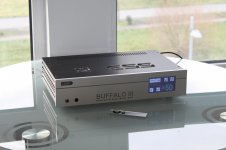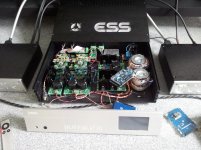The other reason I do it is because I build lots of output stages some with different clearance requirements, so I want the part that won't change to be on the DAC so that if I need different length male headers for different output stages I am able to do that without desoldering anything on the DAC.
Preference, I have just found it easier to line up the modules when assembling that way, that's all.
Thanks. That's what I thought.
I clarified that section:
Buffalo III SE (Stereo Edition) Pro
You can of course do it the other way - but it is much less flexible.
Cheers!
Russ
Buffalo III SE (Stereo Edition) Pro
You can of course do it the other way - but it is much less flexible.
Cheers!
Russ
I just finished my 9038pro build from scratch. The output goes into a tube unbalancer with no gain. My music source is an SD Player from japan, via teleporter. First, the teleporter did not work(contacted brian). I got them hooked up together via 10" wires and it works. Switches between Spdif and PCM/DSD using the EXT_IO, Spdif works via toslink, PCM/DSD, plays all DSD files up to 5.6mhz, but it would not play regular PCM files with 44.1khz 16bit, it plays 176khz 24bit pcm files though. But with 44.1khz, it locks to the file BEFORE it plays, but when it starts playing, it would not stay lock?? Any ideas??? with DSD music, it beats my 9018 BuffaloIIIse, sounds is just fantastic, however, no 44.1khz 16 bit music :>(?
Help,
Alex
Help,
Alex
You might need to make sure you transport is sending 32bit words - otherwise configure the DAC to accept 16 or 24 bits
Yeap. I had same case with my es9038q2m. Only 32bit words worked.
You might need to make sure your transport is sending 32bit words - otherwise configure the DAC to accept 16 or 24 bits
This is the same transport I was using with my 9018 dac and I never had this problem. Anyways, sw 4 & 5 on the dac are both on, I tried turning off 4 and it plays, but very noisy, hiss, no good. I will send pictures later.
Alex
This is the same transport I was using with my 9018 dac and I never had this problem. Anyways, sw 4 & 5 on the dac are both on, I tried turning off 4 and it plays, but very noisy, hiss, no good. I will send pictures later.
Alex
Cool - please reply by email - it will be less noisy on this thread.
Those female analog output headers don't come with the 9038-kit, do they? They must come in the Mercury I/V kit? I'm asking because today I was going to solder them to the bottom of the dac board and see if I have something I could use to connect the female dac connectors to the female connectors on my Legato, probably some copper wire of appropriate gauge.
That's when I discovered they don't come in the dac kit!?
That's when I discovered they don't come in the dac kit!?
Those female analog output headers don't come with the 9038-kit, do they? They must come in the Mercury I/V kit? .....
My 9028 didn't come with the female headers either. Waiting for my Mercury so we'll see.
Fortunately I had some 5/8" (15.875mm) standoffs as the supplied 1/2" (12mm) were too short to stack the 9028 board on my Legato. The female header pins soldered to the bottom of the DAC board touch some of Legato capacitors. I used the supplied caps on my Legato.
Last edited:
9038pro power supply options
I have some questions regarding power supply
1. I have two placid HD from dual mono build, is there any other downside than max current fixed and waste, when putting them in parallel to get 2x500mA, instead of bringing LCDPs...
2. Which configuration would actually be better? is there any difference, as it is going to be regulated any way.
3. In case of using DUAL LCDPs to power only one 9038, does it make sense to put both outputs in parallel 2x500 mA, instead of one out at 1A, and one unused, to decrease heat?
Thanks in advance for answear
The 9038 uses more current than the 9028.
Yes you will definitely want a supply capable of delivering more current than that.
We have a new version of the LCDPs that uses new lower noise regulators that can deliver up to 2A with proper heatsinking. That is what I am using right now - because it's nice not to have to adjust for maximum current and then just waste current most of the time
I strongly recommend people consider using the new LCDPS - especially if you use Cronus. Power the Cronus with one side and the Buffalo with the other.
Cheers!
Russ
I have some questions regarding power supply
1. I have two placid HD from dual mono build, is there any other downside than max current fixed and waste, when putting them in parallel to get 2x500mA, instead of bringing LCDPs...
2. Which configuration would actually be better? is there any difference, as it is going to be regulated any way.
3. In case of using DUAL LCDPs to power only one 9038, does it make sense to put both outputs in parallel 2x500 mA, instead of one out at 1A, and one unused, to decrease heat?
Thanks in advance for answear
I have some questions regarding power supply
1. I have two placid HD from dual mono build, is there any other downside than max current fixed and waste, when putting them in parallel to get 2x500mA, instead of bringing LCDPs...
2. Which configuration would actually be better? is there any difference, as it is going to be regulated any way.
3. In case of using DUAL LCDPs to power only one 9038, does it make sense to put both outputs in parallel 2x500 mA, instead of one out at 1A, and one unused, to decrease heat?
Thanks in advance for answear
1. Unfortunately you really can't parallel them without some hacking
2. The most efficient solution is really best here because of the dynamic load (it changes with sample rate) so I would lean toward LCDPS.
3. Once again - it's not really designed to be paralleled - and there is no need just use one side - save the other side for powering something else - like a cronus
All of that said - you absolutely can use an Placid-HD - you are just going to be burning a ton of shunt current when you play 44.1khz if you also want to play 384khz.
Cheers!
Russ
so from what I've read, if I haven't yet finished the 9018 dual mono build there's no reason to continue on with a dual mono BIIIse Pro28. I should just got with the BIIIse Pro38?
Great question!
That is absolutely my advice. Far less headache and superb results.
You can even power the two sides of the mercury independently if you like.
Cheers!
Russ
Using ESS Voltage Regulator ES9311
Hallo Russ,
ESS Tech released the voltage regulator ES9311 which is made for new DACs series. It suppose to be very good one.
Have you had a look on its specs, are you planning to implement this regulator?
It seems like there are some commercial applications that base on this regulator, is it that good, or just easy implemantation of this dedicated regulator.
best Regards
Hallo Russ,
ESS Tech released the voltage regulator ES9311 which is made for new DACs series. It suppose to be very good one.
Have you had a look on its specs, are you planning to implement this regulator?
It seems like there are some commercial applications that base on this regulator, is it that good, or just easy implemantation of this dedicated regulator.
best Regards
Hallo Russ,
ESS Tech released the voltage regulator ES9311 which is made for new DACs series. It suppose to be very good one...
Yep I tested it - and decided against using it right now.
It's a fine regulator - but we did not like it as well as the current AVCC module for a number of reasons.
BTW nothing would prevent us from creating a new AVCC module using the chip - we just have not found any compelling reason to do so. It's really not any better than what we are currently using. We choose our parts exceedingly deliberately.
Cheers!
Russ
I have one more thing, probably the last one. I know that you wanted to build fully flexible solution from the beginnig, but now, that everybody knows, that Mercury and es9038pro + regs is the way to go, wouldnt it be nice to put it all on one tightly integrated board.
I would be the first one to get this, so I could focus on software.
best Regards
I would be the first one to get this, so I could focus on software.
best Regards
Great question.wouldn't it be nice to put it all on one tightly integrated board.
I would be the first one to get this, so I could focus on software.
Yeah - we did that once - with the Buffalo-32S
The bulk of our builders like experimenting a lot - that's why things are so modular right now.
Cheers!
Russ
Great question.
Yeah - we did that once - with the Buffalo-32SWe may do it again - I know I have learned a ton since then.
The bulk of our builders like experimenting a lot - that's why things are so modular right now.
Cheers!
Russ
That would be great and it seems to me that most of the people experiment with PS.
Anyway, to go for dual mono on es9038pro one have to be insane
I personaly have build dual mono on Buffalo 3 and never really made it working (stucked on I/V stage). It is almost impossible to debug for me, so i couldnt focus on the software and controller.
One intagreted solution would make lots of place for programming, maybe one nice touch screen on raspberry for the community.
I stuck on unfinished this:
An externally hosted image should be here but it was not working when we last tested it.
An externally hosted image should be here but it was not working when we last tested it.
Attachments
- Home
- More Vendors...
- Twisted Pear
- Introducing the Buffalo III-SE-Pro 9028/9038

